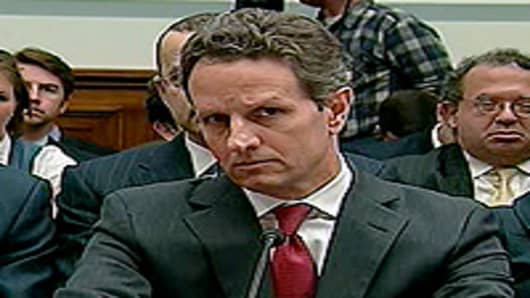Swiss central bankers used loans provided by the New York Federal Reserve to buy loans from UBS, the Swiss banking giant, according to a report from the Government Accounting Office.
The loans were made through a swap agreement that had long been in place to allow Switzerland to provide liquidity to institutions facing dollar funding strains. Several other countries have similar agreements with the Federal Reserve Bank of New York.
But the Swiss National Bank used the swap lines in a very unusual way.
From December 2008 through June 2009, the Swiss National Bank borrowed dollar amounts to help fund a special purpose vehicle that bought mortgage-related securities from UBS. The outstanding balance was often around $13 billion.
The unusual use of the swap lines was approved by the Federal Reserve Bank of New York in the fall of 2008, when it was headed by Tim Geithner. But it was never formally approved by the Federal Open Markets Committee.
“Although the FOMC had delegated approval authority to FRBNY for each swap line draw by the Swiss National Bank, Federal Reserve Board staff said that this proposed use by Swiss National Bank was informally brought to the attention of the FOMC Foreign Currency Subcommittee members for their consideration before the Swiss National Bank’s announcement,” the GAO writes in its audit report.
According to the Federal Reserve Board staff members, they believe a formal consultation was not required and that the New York Fed had the discretion to permit this loan.
How did Geithner and his staff know they had the authority to do this without the formal okay from the Federal Reserve board?
That’s the rub. Apparently, the Fed didn’t have written guidelines for these kind of decisions. The GAO cites this as an example of where the Fed lacks documented guidance for when decisions could be made by Fed branch chiefs and when they should go to the Federal Reserve Board.
The GAO doesn’t say that Geithner got it wrong with the bailout of UBS. But it does point out that there is a risk of a Fed president “going rogue.”
From the report:
Without documented guidance for Reserve Banks on types of program decisions that require consultation with the Federal Reserve Board, Reserve Bank staff and officials may fail to escalate significant policy decisions to the appropriate set of policymakers at the Federal Reserve Board. This uncertainty may increase the risk that a Reserve Bank may permit an exceptional use of emergency assistance that is inconsistent with the Federal Reserve Board’s policy goals or exposes the Federal Reserve System to increased reputational risk.
That’s a very polite way of saying that maybe it would have been a better idea for the Federal Reserve Board to carefully consider whether the Fed should be lending Swiss central bankers money to buy assets from a Swiss bank. This could easily have escalated into a major scandal if the public knew that our central bankers were bailing out a foreign bank.
On the other hand, you can see the benefits to the Fed of not putting these formal controls in place. It makes the Fed far less transparent—which frees it from public accountability and political control. In short, this kind of ad hoc decision making may be a way for the Fed to maintain its independence.
Questions? Comments? Email us atNetNet@cnbc.com
Follow John on Twitter @ twitter.com/Carney
Follow NetNet on Twitter @ twitter.com/CNBCnetnet
Facebook us @ www.facebook.com/NetNetCNBC



